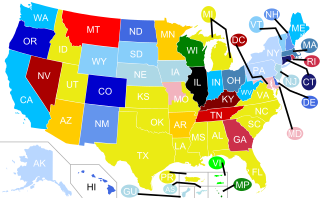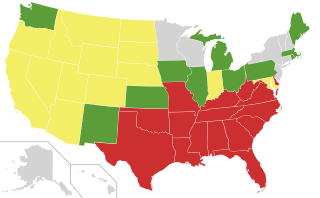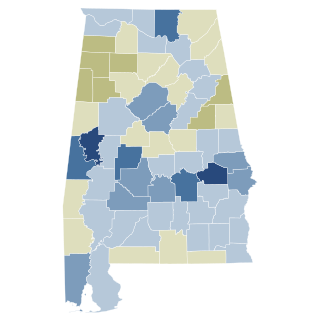Loving v. Virginia, 388 U.S. 1 (1967), was a landmark civil rights decision of the U.S. Supreme Court in which the Court ruled that laws banning interracial marriage violate the Equal Protection and Due Process Clauses of the Fourteenth Amendment to the U.S. Constitution. The case involved Mildred Loving, a woman of color, and her white husband Richard Loving, who in 1958 were sentenced to a year in prison for marrying each other. Their marriage violated Virginia's Racial Integrity Act of 1924, which criminalized marriage between people classified as "white" and people classified as "colored". The Lovings appealed their conviction to the Supreme Court of Virginia, which upheld it. They then appealed to the U.S. Supreme Court, which agreed to hear their case.

Sodomy laws in the United States, which outlawed a variety of sexual acts, were inherited from colonial laws in the 17th century. While they often targeted sexual acts between persons of the same sex, many statutes employed definitions broad enough to outlaw certain sexual acts between persons of different sexes, in some cases even including acts between married persons.

In 1924, the Virginia General Assembly enacted the Racial Integrity Act. The act reinforced racial segregation by prohibiting interracial marriage and classifying as "white" a person "who has no trace whatsoever of any blood other than Caucasian." The act, an outgrowth of eugenist and scientific racist propaganda, was pushed by Walter Plecker, a white supremacist and eugenist who held the post of registrar of Virginia Bureau of Vital Statistics.
Massachusetts General Laws Chapter 207, Section 11, more commonly known as the 1913 law, is a Massachusetts law enacted in 1913 and repealed in 2008 that invalidated the marriage of non-residents if the marriage was invalid in the state where they lived. It originated during a period of heightened antipathy to interracial marriage and went largely unenforced until used between 2004 and 2008 to deny marriage licenses to out-of-state same-sex couples.
McLaughlin v. Florida, 379 U.S. 184 (1964), was a case in which the United States Supreme Court ruled unanimously that a cohabitation law of Florida, part of the state's anti-miscegenation laws, was unconstitutional. The law prohibited habitual cohabitation by two unmarried people of opposite sex, if one was black and the other was white. The decision overturned Pace v. Alabama (1883), which had declared such statutes constitutional. It did not overturn the related Florida statute that prohibited interracial marriage between whites and blacks. Such laws were declared unconstitutional in 1967 in Loving v. Virginia.
Perez v. Sharp, also known as Perez v. Lippold or Perez v. Moroney, is a 1948 case decided by the Supreme Court of California in which the court held by a 4–3 majority that the state's ban on interracial marriage violated the Fourteenth Amendment to the United States Constitution.
The race of the future is a theoretical composite race which will result from the ongoing racial admixture.

The Edmunds Act, also known as the Edmunds Anti-Polygamy Act of 1882, is a United States federal statute, signed into law on March 23, 1882 by President Chester A. Arthur, declaring polygamy a felony in federal territories, punishable by "a fine of not more than five hundred dollars and by imprisonment for a term of not more than five years". The act is named for U.S. Senator George F. Edmunds of Vermont. The Edmunds Act also prohibited "bigamous" or "unlawful cohabitation", thus removing the need to prove that actual marriages had occurred. The act not only reinforced the 1862 Morrill Anti-Bigamy Act but also made the offense of unlawful cohabitation much easier to prove than polygamy misdemeanor and made it illegal for polygamists or cohabitants to vote, hold public office, or serve on juries in federal territories.

Mildred Delores Loving and Richard Perry Loving were an American married couple who were the plaintiffs in the landmark U.S. Supreme Court case Loving v. Virginia (1967). Their marriage has been the subject of three movies, including the 2016 drama Loving, and several songs. The Lovings were criminally charged with interracial marriage under a Virginia statute banning such marriages, and were forced to leave the state to avoid being jailed. They moved to Washington, D.C., but wanted to return to their home town. With the help of the American Civil Liberties Union (ACLU), they filed suit to overturn the law. In 1967, the Supreme Court ruled in their favor, striking down the Virginia statute and all state anti-miscegenation laws as unconstitutional, for violating due process and equal protection of the law under the Fourteenth Amendment. On June 29, 1975, a drunk driver struck the Lovings' car in Caroline County, Virginia. Richard was killed in the crash, at the age of 41. Mildred lost her right eye.
Marriage in the United States is a legal, social, and religious institution. The marriage age in the United States is set by each state and territory, either by statute or the common law applies. An individual may marry in the United States as of right, without parental consent or other authorisation, on reaching 18 years of age in all states except in Nebraska, where the general marriage age is 19, and Mississippi, where the general marriage age is 21. In Puerto Rico the general marriage age is also 21. In all these jurisdictions, these are also the ages of majority. In Alabama, however, the age of majority is 19, while the general marriage age is 18. Most states also set a lower age at which underage persons are able to marry with parental and/or judicial consent. Marriages where one partner is less than 18 years of age are commonly referred to as child or underage marriages.

Interracial marriage has been legal throughout the United States since at least the 1967 U.S. Supreme Court decision Loving v. Virginia (1967) that held that anti-miscegenation laws were unconstitutional via the 14th Amendment adopted in 1868. Chief Justice Earl Warren wrote in the court opinion that "the freedom to marry, or not marry, a person of another race resides with the individual, and cannot be infringed by the State." Since Loving, several states repealed their defunct bans, the last of which was Alabama in a 2000 referendum. Interracial marriages have been formally protected by federal statute through the Respect for Marriage Act since 2022.

Naim v. Naim, 197 Va. 80; 87 S.E.2d 749 (1955), is a case regarding interracial marriage. The case was decided by the Supreme Court of Virginia on June 13, 1955. The Court held the marriage between the appellant and the appellee to be void under the Code of Virginia (1950).
Bernard S. Cohen was a civil liberties attorney and Democratic member of the Virginia House of Delegates. On April 10, 1967, appearing with co-counsel Philip Hirschkop on behalf of the ACLU, Cohen presented oral argument for the petitioners in Loving v. Virginia before the U. S. Supreme Court. On June 12, 1967, the Supreme Court ruled in favor of Cohen's clients, declaring bans on interracial marriage unconstitutional, thus invalidating the anti-miscegenation laws of 15 states.
Anti-miscegenation laws are laws that enforce racial segregation at the level of marriage and intimate relationships by criminalizing interracial marriage and sometimes also sex between members of different races.

In the United States, anti-miscegenation laws were passed by most states to prohibit interracial marriage, and in some cases also prohibit interracial sexual relations. Some such laws predate the establishment of the United States, some dating to the later 17th or early 18th century, a century or more after the complete racialization of slavery. Nine states never enacted such laws; 25 states had repealed their laws by 1967, when the United States Supreme Court ruled in Loving v. Virginia that such laws were unconstitutional in the remaining 16 states. The term miscegenation was first used in 1863, during the American Civil War, by journalists to discredit the abolitionist movement by stirring up debate over the prospect of interracial marriage after the abolition of slavery.
Ophelia (Catata) Paquet was a Tillamook woman involved in an Oregon court case in year 1919 related to the legal recognition of marriage across racial lines. The case's issue was whether Ophelia Paquet could inherit her deceased Euro-American husband's estate in the U.S. state of Oregon. Her case exemplifies the role that marriage has in the transmission of property and how race can affect gender complications.
Julie Novkov is an American political scientist, currently a professor of political science and women’s, gender, and sexuality studies at the University at Albany, SUNY. She studies the history of American law, American political development, and subordinated identities, with a focus on how laws are used for social control while also being affected by social reform movements.

2000 Alabama Amendment 2, also known as the Alabama Interracial Marriage Amendment, was a proposed amendment to the Constitution of Alabama to remove Alabama's ban on interracial marriage. Interracial marriage had already been legalized nationwide 33 years prior in 1967, following Loving v. Virginia, making the vote symbolic. The amendment was approved with 59.5% voting yes, a 19 percentage point margin, though 25 of Alabama's 67 counties voted against it. Alabama was the last state to officially repeal its anti-miscegenation laws.







